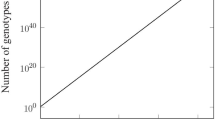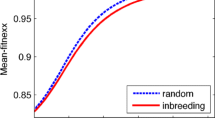Summary
The effect of the number of parents and their level of inbreeding on the mean and the variance of synthetic varieties was studied for diploids and autotetraploids. The number of parents and their level of inbreeding act in opposing ways. Maximum mean requires a high number of parents and no inbreeding. Maximum variance requires a small number of highly inbred and unrelated parents. When the number of parents increases (k ≥ 2) the coefficients of the components of variance decrease, and the decrease is more rapid for variances associated with increasing order of interactions between genes. The coefficients of components of variance increase as the level of inbreeding of the parents increases and the increase is greater for components associated with increasing order of interactions between genes.
Consequently, according to the values of inbreeding depression and the components of genetic variance and heritability, an optimum genetic base may exist, i.e., an ideal combination of the number of parents and the level of their inbreeding. With no inbreeding, selection among synthetics uses mainly additive variance. By increasing the level of inbreeding of the parents, the effects of dominance and of additive X additive variances on genetic advance when selecting among synthetics increase. One cycle of selection among synthetics appears more efficient than individual selection within populations. The problem of population improvement before selecting among synthetics is discussed.
Similar content being viewed by others
Literature
Bouffette, Jacqueline: Expression de la covariance génotypique chez les tetraploides. Thése doctorat 3eme cycle Fac. Sci. Lyon (1966).
Busbice, Thad H.: Inbreeding in synthetic varieties. Crop Sci. 9, 601–604 (1969).
Busbice, Thad H.: Predicting yield of synthetic varieties. Crop Sci. 10, 265–269 (1970).
Cockerham, C. C.: Implication of genetic variances in a hybrid breeding program. Crop Sci. 1, 47–52 (1961).
Comstock, R. E., Robinson, H. F.: The components of genetic variance in populations. Biometrics 4, 254–266 (1948).
Corkill, L.: The basis of synthetic strains of cross-pollinated grasses. 7th Intl. Grassl. Cong. 427 (1956).
Dessureaux, L., Gallais, A.: Evolution of fertility in advanced generations of an alfalfa single cross hybrid. Canad. J. Genetics and Cytol, 13, 834–841 (1971).
Gallais, A.: Evolution de la vigueur des variétés synthétiques diploïdes au cours des générations de multiplication. I. En panmixie. Ann. Amélior. Plantes 17, 291–301 (1967a).
Gallais, A.: Moyennes des populations tetraploides. Ann. Amélior. Plantes 17, 215–228 (1967b).
Gallais, A.: Evolution de la vigueur des variétés synthétiques tetraploides au cours des générations de multiplication. I. En panmixie. Ann. Amélior. Plantes 18, 5–15 (1968a).
Gallais, A.: Etude théorique et comparée de la vigueur de différentes structures variétaies chez les plantes allogames autotétraploïdes. Ann. Amélior. Plantes 18, 99–124 (1968b).
Gallais, A.: Interactions between alleles and their variability in autotetraploid cross-fertilised plants. Consequences for selection. Genetica Agraria XXII, 312–323 (1969).
Gallais, A.: Evolution de la vigueur des variétés synthétiques diploïdes au cours des générations de multiplication. II. Avec déviations par rapport à la panmixie. Ann. Amelior. Plantes 20, 5–26 (1970a).
Gallais, A.: Covariances entre apparentés quelconques avec linkage et épistasie. II. Evolution en régime d'autofécondation. Ann. Génét. Sél. Anim. 2, 417–427 (1970b).
Gallais, A.: Nouvelle contribution à l'étude de la vigueur des variétés synthétiques tétraploïdes dans le cas de panmixie. Ann. Amélior. Plantes 21, 141–168 (1971a).
Gallais, A.: Evolution de la vigueur des variétés synthétiques tétraploides au cours des générations de multiplication. II. Avec déviations par rapport à la panmixie; influence de l'autostérilité, cas particulier de la multiplication des hybrides. Ann. Amélior. Plantes 21, 303–336 (1971b).
Gallais, A.: Evolution de la vigueur des variétés synthétiques diploïdes au cours des générations de multiplication. III. Influence de l'épistasie et du linkage dans le cas de panmixie et de croisement préférentiel. Ann. Amélior. Plantes 21, 343–371 (1971c).
Gallais, A., Guy, P.: Breeding for heterosis in autotetraploïds. Report of Fodder Crops Section of Eucarpia, Lusignan 15–17 Sept. 1970.
Gallais, A., Guy, P., Lenoble, M.: Models for varieties in crossfertilized forage plants. Proc. 11th Inter. Grassland Cong. 254–259 (1970).
Gillois, M.: La relation d'identité en génétique. Thèse fac. sci. Paris, 295 P. (1964).
Griffing, B.: Comparisons of potentials for general combining ability selection methods utilizing one or two random mating populations. Aust. J. Biol. Sci. 16, 838–862 (1963).
Griffing, B.: Selection in reference to biological groups. I. Individual and group selection applied to populations of unordered groups. Aust. J. Biol. Sci. 20, 127–139 (1966).
Harris, D. L.: Genotypic covariances between inbred relatives. Genetics 50, 1319–1348 (1964).
Hill, R. R., Jr.: Effect of the number of parents on the mean and variance of synthetic varieties. Crop Sci. 11, 283–286 (1971).
Kehr, W. R., Graumann, H. D., Lowe, C. C., Gardner, C. O.: The performance of alfalfa synthetics in the first and advanced generations. Univ. of Nebraska. Research Bull. n ° 200 (1961).
Kempthorne, O.: An introduction to genetic statistics. New York: John Wiley and Sons, Inc., 1957.
Kinman, M. L., Sprague, G. F.: Relation between number of parental lines and theoretical performance of synthetic varieties. J.Amer.Soc.Agron. 22, 614–626 (1945).
Malécot, G.: Les mathématiques de l'hérédité. Paris: Masson et Cie. 1948.
Mather, K.: Biometrical genetics. London: Methuen 1949.
Wright, S.: The effects of inbreeding and cross-breeding on guinea pigs. U.S.D.A. Bull. 1121 (1922).
Author information
Authors and Affiliations
Additional information
Communicated by J.E. Legates
Rights and permissions
About this article
Cite this article
Gallais, A. Selection among synthetics. Theoret. Appl. Genetics 44, 24–30 (1974). https://doi.org/10.1007/BF00277704
Received:
Issue Date:
DOI: https://doi.org/10.1007/BF00277704




